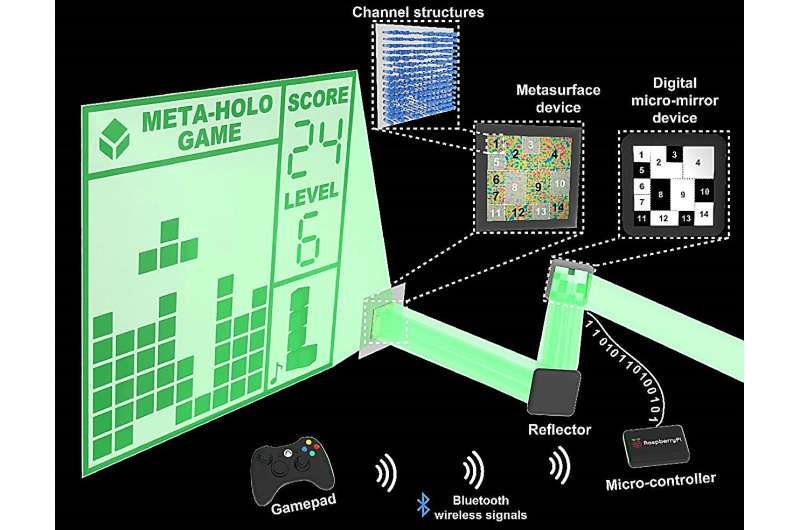System architecture diagram of an interactive holographic Tetris game implemented using bitwise dynamic metasurface holography. Image source: Compuscript Ltd
Computer-generated holography (CGH) represents a cutting-edge technology that uses computer algorithms to dynamically reconstruct virtual objects. This technology has wide applications in three-dimensional display, optical information storage and processing, entertainment, encryption and other fields.
Although CGH has a wide range of applications, contemporary technology mainly relies on projection devices such as spatial light modulators (SLM) and digital micromirror devices (DMD). These devices inherently face limitations in display capabilities, often resulting in narrow fields of view and multi-order diffraction in the projected image.
In recent developments, metasurfaces composed of arrays of subwavelength nanostructures have shown remarkable capabilities in modulating electromagnetic waves. By introducing sudden changes in fundamental wave characteristics such as amplitude and phase through subwavelength-scale nanostructures, metasurfaces achieve modulation effects that are difficult to achieve with traditional devices.
Advances in metasurface-based holography have led to major achievements such as large viewing angles, achromatic imaging, full-color displays, increased information capacity, and multidimensional multiplexing, making them powerful tools for dynamic holographic displays.
Despite this, dynamic metasurface holographic technology still faces huge challenges in achieving the instant, highly smooth dynamic display effects required for advanced displays such as advanced human-computer interaction. The key to fluid metasurface holographic displays is achieving high computing and display frame rates. Computing frame rate refers to the speed at which data is calculated, processed and prepared for display, ensuring that the system can calculate the required content in real time.
Most current holographic display solutions rely heavily on multiple executions of Fast Fourier Transform (FFT), which usually requires dedicated computing units such as graphics processing units (GPUs) to meet the needs of high refresh rates, which makes computing power and Energy consumption has become a key bottleneck for widespread applications. application.
On the other hand, display frame rate, or how quickly a display refreshes and presents new content, is critical to the smoothness of visual content. Currently, most metasurface-based dynamic holographic display strategies struggle to achieve high display frame rates, which limits their ability to provide a smooth visual experience.
In response to these challenges, a team led by Professor Xiong Wei and Associate Professor Gao Hui from Wuhan Optoelectronics National Laboratory of Huazhong University of Science and Technology launched a dynamic interactive bit surface holography technology (Bit-MH) with high computing and display framework. They constructed the world’s first practical interactive metasurface holographic display system.
Their research was published in Optoelectronic progress, the team divided the display function of the metasurface into different spatial regions or channels, each of which is capable of projecting reconstructed sub-holographic patterns. They used optical addressing for spatial channel multiplexing to map the on/off states of all channels to a set of bit values, thus converting the dynamic update process of the hologram into manipulating these bit values to control the corresponding channels.
This method significantly improves computational efficiency by using mapped bit operations rather than relying on the frequent FFT calculations required for traditional dynamic holographic updates, thereby achieving efficient dynamic refresh.
The researchers conducted a benchmark test on the bit-dynamic holographic core algorithm on the low-power Raspberry Pi computing platform. The results showed that the maximum calculation frame rate of the bit-dynamic holographic method can reach 800 kHz. In addition, by using high-speed DMD optical addressing devices, they achieved a maximum display frame rate of 23 kHz.
To demonstrate this concept, the research team built an interactive holographic gaming system for playing Tetris within the visible spectrum. The core components of the system include the space-segmented metasurface device, DMD, Raspberry Pi controller, game controller, and necessary optical components.
The proposed bit-dynamic holographic design allows efficient updating of holographic images and instant interaction with external input devices. This efficient and programmable Bit-MH approach is expected to pave the way for smooth and efficient metasurface holographic display systems in the future.
More information:
Yun Cheng Liu et al., Dynamic interactive bitholography with ultra-high computing and display frame rates, Optoelectronic progress (2023). DOI: 10.29026/oea.2024.230108
Provided by Compuscript Ltd.
citation: Dynamic interactive bitholography with ultra-high computing and display frame rates (2023, December 21) Retrieved December 22, 2023, from https://phys.org/news/2023-12-dynamic -interactive-bitwise-meta-holography-meta-holography.html
This document is protected by copyright. No part may be reproduced without written permission except in the interests of fair dealing for private study or research purposes. Content is for reference only.
#Dynamic #interactive #bitbybit #holography #ultrahigh #computing #display #frame #rates
Image Source : phys.org
